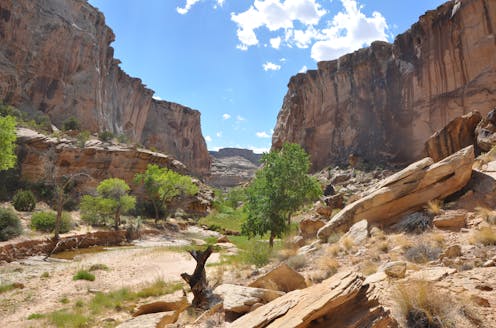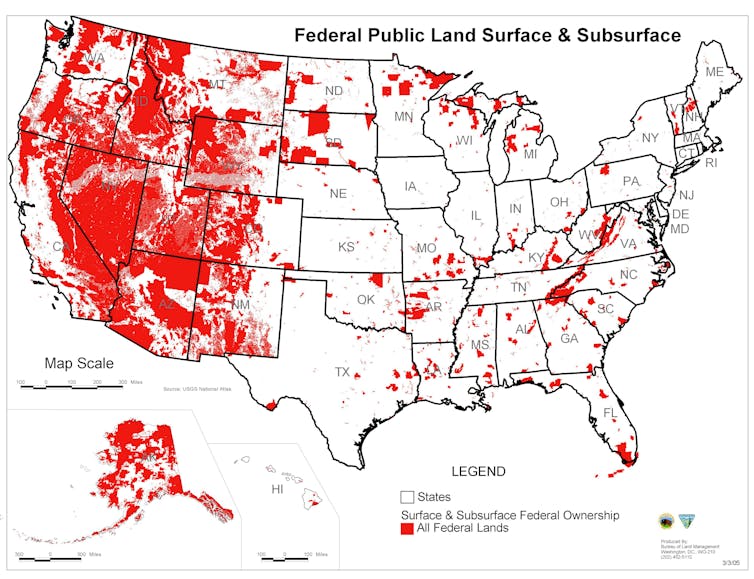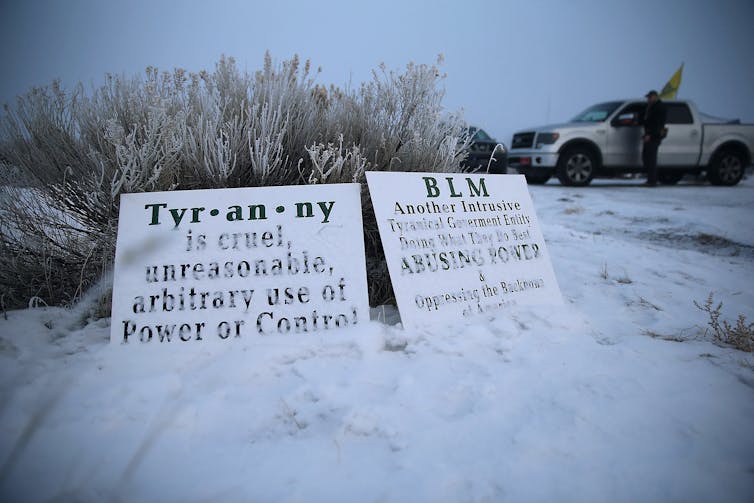The 2020 elections will determine which voices dominate public land debates
Republicans and Democrats take sharply different positions on managing US public lands, but there's solid consensus on some issues.

Presidential elections are anxious times for federal land agencies and the people they serve. The Bureau of Land Management, National Park Service, U.S. Fish and Wildlife Service and U.S. Forest Service manage more than a quarter of the nation’s land, which means that a new president can literally reshape the American landscape.
Federal influence is particularly significant in the Western U.S. Across the 11 states from the Rocky Mountains to the Pacific Coast, the federal government owns more than 45% of all land. In Alaska it owns over 60%.
Voters have a striking choice this year. President Donald Trump entered office committed to the “deconstruction of the administrative state.” His administration raced to reduce environmental planning and regulations and expand private development in pursuit of “energy dominance.”

In contrast, Vice President Biden’s campaign proposals for public lands remain fairly broad, but are largely consistent with the Obama administration’s priorities. The most significant difference is Biden’s pledge to end new fossil fuel leasing on public lands.
How would each candidate fulfill these promises? As I explain in my new book, “This Land Is My Land: Rebellion in the West,” public lands are a microcosm of today’s polarized American politics.
On the right, mainstream conservatives and industrial corporations want reduced regulation and increased resource development, while a more militantly anti-federal element of the Republican Party demands an end to public land ownership altogether. On the left, mainstream Democrats want carefully regulated land management with increased margins of environmental protection, but a vocal progressive wing is demanding that the federal government keep its fossil fuels in the ground. These tensions raise questions about how far each candidate would go.
Republicans: Less regulation, more development
Since Ronald Reagan ran 40 years ago as a self-proclaimed “sagebrush rebel” who supported turning control of public lands back to Western states, Republicans have coalesced around a set of common public land priorities. They include reducing federal regulation, limiting the scope of environmental reviews and increasing natural resource development.
This approach has drawn support from natural resource industries, resource-dependent communities and a growing body of public interest law firms, think tanks, advocacy groups, foundations and political action committees. Their core libertarian conviction is that reducing government leads to prosperity.

The Trump administration has championed these priorities through actions that include shrinking several national monuments to expand oil leasing; preparing to open the Arctic National Wildlife Refuge for oil production; and narrowing environmental reviews of major federal actions. The full impact of these actions is hard to assess, since many face challenges in court, where the administration has fared poorly. But their theme is clear: Public lands are open for business.
As part of this effort, the Trump administration moved the Bureau of Land Management’s headquarters from Washington, D.C., to Grand Junction, Colorado. The agency has struggled to staff the new building, which it shares with several oil and gas companies.
A vocal element of the Republican Party challenges the federal government’s authority to own and manage public lands at all. Some advocates have engaged in armed confrontations with federal authorities. Several Western states have enacted legislation over the past decade demanding that the federal government transfer ownership of public lands and mineral rights to them.
President Trump has catered to this extreme wing while stopping short of meeting its explicit demands. He signaled support by appointing conservative activist William Perry Pendley as the Bureau of Land Management’s functional acting director in July 2019 – a step that a federal court in Montana recently ruled was illegal because it bypassed a confirmation hearing. Pendley was known for staunch opposition to public land ownership and years of litigation over public land management.
The president also has pardoned controversial figures who are embraced by opponents of public land authority, including former Arizona Sheriff Joe Arpaio and two Oregon ranchers convicted of arson on federal property.
Despite his administration’s losses in court, I expect that if President Trump is reelected he will continue down this path of deregulation, resource development and deference to conservative Western interests, with occasional gestures of support to more radical conservatives.
Democrats: Scientific management with limited development
Recent Democratic presidents, from Jimmy Carter to Barack Obama, have championed federal environmental laws that guide public land management, such as the National Environmental Policy Act and the Endangered Species Act. Democratic administrations have emphasized scientific monitoring and regulatory oversight while still supporting energy development and other commercial resource uses of public lands.
Vice President Biden’s long environmental record and campaign pledges suggest that he will continue this approach. Biden has promised to reverse the Trump administration’s deregulatory efforts, restore national monument boundaries and manage energy development on public lands in ways that promote wind and solar energy and gradually phase out fossil fuel development.
But a Biden administration would face tensions within the Democratic Party as well. Progressives are calling for more dramatic action to slow climate change, including bans on hydraulic fracturing for oil and gas production and on new oil, gas and coal leases on public lands. Biden has signaled strong support for this agenda, but insists that hydraulic fracturing and fossil fuel development will continue on existing leases.
A Biden administration, then, would likely seek to restore President Obama’s public lands legacy and push beyond it with tighter limits on fossil fuel production.
Everybody loves the outdoors
These sharply different visions can obscure the fact that there is substantial commitment to public lands, especially as places for hunting, fishing, camping and other recreational uses. This consensus was evident when Congress passed the Great American Outdoors Act of 2020 in July with strong bipartisan support. With an eye on election polls, President Trump bragged that signing the bill made him the greatest environmental president since George Washington.
[Deep knowledge, daily. Sign up for The Conversation’s newsletter.]
As I see it, this bill was popular because it did not address controversial questions like regulation or energy development. Instead it provided billions of dollars for maintaining roads, trails, visitor centers and other public land infrastructure. It also guaranteed permanent funding for the Land and Water Conservation Fund, which uses money from federal fossil fuel royalties to protect valuable lands and waters from development.
That pairing suggests that public land ownership and fossil fuel development will both be part of the next administration. But the election will determine how these resources will be managed, and who will have the most influence over this process.
James R. Skillen is a member of the Public Lands Foundation.
Read These Next
What’s at stake in Trump’s executive order aiming to curb state-level AI regulation
In the absence of comprehensive federal AI regulation, states have stepped in. The Trump administration,…
Data centers need electricity fast, but utilities need years to build power plants – who should pay?
How many data centers will be built – and how much electricity they’ll need – is uncertain. Being…
Whether Netflix or Paramount buys Warner Bros., entertainment oligopolies are back – bigger and mor
Hollywood has seen this movie before.





